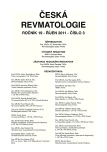Prevention of adverse gastrointestinal events of nonsteroidal anti-inflammatory drugs with proton pump inhibitors. Results of the epidemiologic study GREAT
Authors:
Š. Forejtová; K. Pavelka; Z. Mareš
Authors‘ workplace:
Revmatologický ústav Praha
Published in:
Čes. Revmatol., 19, 2011, No. 3, p. 104-110.
Category:
Original Papers
Overview
The aim of our study
was to survey the forms of gastroprotective therapy used in the Czech Republic during the treatment with nonsteroidal anti-rheumatic drugs (NSAIDs) in patients with chronic rheumatic diseases with different risk factors for NSAID-induced gastropathy.
Methods:
We conducted a multicentric study with data collected directly by rheumatologists. Administration of NSAIDs for at least 4 days a week in the last 3 months was considered as chronic use. The study had two parts: the first part was a cross-sectional study with a one-time record of use of gastroprotective therapy at the time of questionnaire completion; the second part was a retrospective observation of adverse effects in the last 3 months.
Results:
90 rheumatologists participated in our survey. Records were collected for a total of 869 patients: 275 men (31.65%) and 594 women (68.35%). A total of 789 patients (90.79%) were at risk of NSAID-induced gastropathy; with 397 (45.68%) at high-risk and 392 patients (45.10%) at low risk. At least one gastroprotective drug was used in 648 (74.57%) individuals (coxibs, H2-blockers or proton pump inhibitors), with omeprazole being the most commonly used gastroprotective agent (94.41%). The relationship between risk of NSAID-induced gastropathy and gastroprotective agent used reached statistical significance (p<0.01, r = 0.349); ie gastroprotective drugs were used in 83.88% patients at high risk of gastropathy, in 73.72% patients with low risk, and in 32.50% patients with no risk. No gastroprotective drugs were used in 16.18% high-risk patients and in 26.27% patients with low risk of gastropathy. 672 (77.33%) out of all monitored individuals experienced no difficulties during the NSAIDs treatment, whereas 197 (22.66%) individuals had some ailments under the treatment with NSAIDs.
Conclusion:
We have found a significant correlation between the GI risk and use of gastroprotective drug. The most commonly used agent was omeprazole (94.41%). However 19.22% of all monitored individuals with at least one risk factor for NSAID-induced gastropathy were not treated with any gastroprotective drug.
Key words:
NSAID-induced gastropathy, gastroprotective therapy, proton pump inhibitors, omeprazole
Sources
1. Laine L. Approaches to nonsteroidal anti-inflammatory drug use in the high-risk patient. Gastroenterology 2001;120(3):594-606.
2. Pirmohamed M, James S, Meakin S et al. Adverse drug reactions as cause of admission to hospital: prospective analysis of 18 820 patients. BMJ 2004;329:15-19.
3. Laine L, Bombardier C, Hawkey CJ, Davis B, Shapiro D, Brett C, Reicin A. Stratifying the risk of NSA-related upper gastrointestinal clinical events: result of a double-blind outcomes study in patients with rheumatoid arthritis. Gastroenterology 2002;123(4):1006-1012.
4. Bombardier C, Laine L, Reicin A et al. Comparison of upper gastrointestinal toxicity of rofecoxib and naproxen in patients with rheumatoid arthritis. VIGOR Study Group. N Engl J Med 2000;343(21):1520-1528.
5. Fries JF, Williams Ca, Bloch DA et al. Nonsteroidal anti-inflammatory drugs associated gastropathy: incidence and risk factor model. Am J Med 1991:91:213-222.
6. Griffin MR, Piper JM, Daugherty JR et al. Nonsteriodal anti-inflammatory drug use and increased risk for peptic ulcer in elderly persons. Ann Intern Med 1991;114:257-263.
7. Piper JM, Ray WA, Daugherty JR et al. Corticosteroid use and peptic ulcer disease. Role of non-steroidal anti-inflammatory drugs. Ann Intern Med 1991;114:735-740.
8. Shorr RJ, Ray WA, Daugherty JR et al. Concurent use of nonsteroidal anti-inflammatory drugs and oral anticoagulants places elderly persons at high risk for hemorrhagic peptic ulcer diseases. Arch Intern Med 1993;153:1665-1670.
9. Silverstein FE, Graham DY, Senior JR et al. Misoprostol reduces serious gastrointestinal complications in patients with rheumatoid arthritis receiving nonsteroidal anti-inflammatory drugs. A randomised, double blind, placebo controlled trial. Ann Intern Med 1995;123:241-249.
10. Chan FKL, Hung LCT, Suen BY et al. Celecoxib versus diclofenac plus omeprazole in high-risk arthritis patients: Result of a randomised double blind trial. Gastroenterology 2004;127:1038-1043.
11. Rostom A, Dube C, Wells GA, Tugwell P, Welch V, Jolicoeur E, McGowan J, Lanas A. Prevention of NSAID-induced gastroduodenal ulcers (Review). Cochrane Database Syst Rev. 2002;(4):CD002296.
12. Silverstein FE, Faich G, Goldstein JL et al. Gastointestinal toxicity with celecoxib vs. nonsteroidal anti-inflammatory drugs for osteoarthritis and rheumatoid arthritis: the CLASS study: a randomized controlled trial. Celecoxib long-therm artrhritis safety study. JAMA 2000;284(10): 1247-1255.
13. Schnitzer T, Burmester GR, Mysler E et al. Comparison of lumiracoxib with naproxen and ibuprofen in the Therapeutic Arthritis Research and Gastrointestinal Event Trial (TARGET), reduction in ulcer complications: randomised controlled trial. Lancet 2004;364:665-674
14. Hawkey CJ, Gitton X, Hoexter E, Richard D, Einstein WM. Gastrointestinal tolerability of lumiracoxib in patients with osteoarthritis and rheumatoid arthritis. Clin Gastroenterol Hepatol 2006;4:57-66.
15. Hunt RH, Harper S, Watson DJ et al. The gastrointestinal safety of the COX-2 selective inhibitor etoricoxib assessed by both endoscopy and analysis of upper gastrointestinal events. Am J Gastroenterol 2003;98:1725-1733.
16. Fries JF, Murtagh KN, Bennett M, Zatarain E, Lingala B, Bruce B. The rise and decline of nonsteroidal antiinflammatory drug-associated gastropathy in rheumatoid arthritis. Arthritis Rheum 2004;50:2433-40.
17. Steen KSS, Nurmohamed MT, Visman I, Heijerman M, Boers M, Dijkmans BAC, Lems WF. Decreasing incidence of symptomatic gastrointestinal ulcer complications in patients with rheumatoid arthritis. Ann Rheum Dis 2008;67:256-259.
18. Roux C, Briot K, Gossec L et al. Increase of fracture risk in postmenopausal women using omeprazol. Calcif Tissue Int 2009;24:100-103.
Labels
Dermatology & STDs Paediatric rheumatology RheumatologyArticle was published in
Czech Rheumatology

2011 Issue 3
Most read in this issue
- Hallux valgus in patients with rheumatoid arthritis – current surgical treatment options
- Mikulicz´s disease with unilateral exophtalmia – IgG4 related disease
- Real life results of rituximab in treatment of active rheumatoid arthritis
- Prevention of adverse gastrointestinal events of nonsteroidal anti-inflammatory drugs with proton pump inhibitors. Results of the epidemiologic study GREAT
